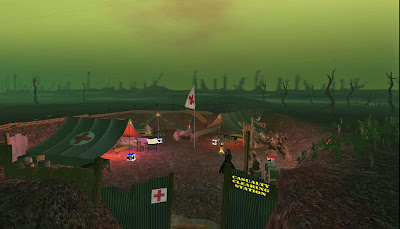[Click for Part 1, Part 2, Part 3, Part 4, Part 5, and Part 6.]
My next stop was the Patterson house. I knew Farley Patterson was a widower who had not remarried, but that he shared his house with his daughter. Angela Patterson turned out to be a matronly woman in her late thirties. She answered the door in enormous denim pants with an elastic waistband, and a large white cotton undergarment in place of a blouse and corset. Strange customs indeed.
“Miss Patterson? Pardon me for intruding in your time of grief, but I come on behalf of Commodore Billings.”
Her eyes seemed to have trouble focusing, as though she had been drinking. “T-Tom Billings? He was a friend of Dad’s, over for dinner at least once a month, but that thieving nephew of his k-killed my father.” She turned and walked away from the door, deeper into the house. I took this as an invitation and followed. “What does Tom want from us?”
I explained that he had doubts as to Jason Billings’ complicity in the murder. “Just to put his mind at ease, he asked me to talk to some of Professor Patterson’s family, friends, and business associates.”
“Jason’s guilty as hell. He took our money, then he killed Dad. It’s that simple.”
“I do not dispute that Mr. Jason Billings defrauded his clients, including your father. What motivation would he have to murder Mr. Patterson as well?”
“I don’t know – just mad at Dad, I suppose.”
“Did he know what your father was working on? Could Mr. Billings – or anyone else – have wanted to steal one of his inventions?”
She shrugged. “Could be. But Dad kept everything tightly locked away. His papers are in a safe and no one knows the combination, even me. His lab has more security on it than a bank vault, and without his notes the stuff in the lab wouldn’t be worth anything anyway.”
“Did anyone except Mr. Billings bear animus against your father?”
“Bear what?”
“Hold a grudge against him.”
“Oh, why didn’t you just say so. Not that I can think of. Nope. Dad was such an easy-going guy that he didn’t take offense when Tom yelled at him the last time Tom was over here.”
“What was the dispute about?”
She waved a hand. “Oh, who knows? I didn’t really hear it, just Tom’s voice raised, saying something about wanting in on it. Dad said something calmly, and Tom calmed down, too. Nothing more happened.”
Changing directions, I asked, “With your father gone, who inherits his estate and his inventions?”
“Well, I do, of course. I’m his only family.” Her eyes narrowed. “Why? Wha- you don’t think I had something to do with this? My own father? Besides, we’re not rich. It takes a lot of dough to keep the lab going, and he sold off at least half the profits from his inventions just to raise cash. Without him around to make new things that people want to buy…well, he’s a lot more valuable alive than dead. I loved him, of course,” she added hastily.
I thanked her for her time and let myself out. No doubt there were other avenues to explore, but I was tired and hungry, so I returned to the hotel and ordered dinner from room service, including a fifth of a whisky I had never tasted, one that called itself Jack Daniel’s.
Perhaps the East Avaria Company could import some of this, I thought as my eyes closed and I was out for the night.





















































